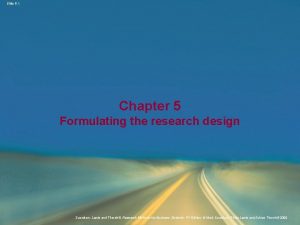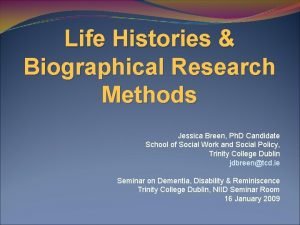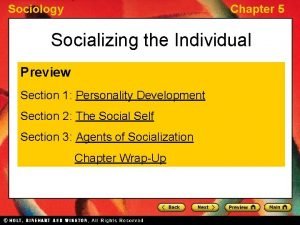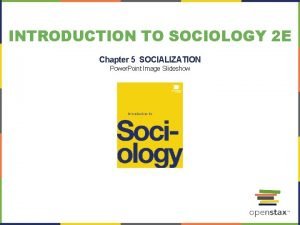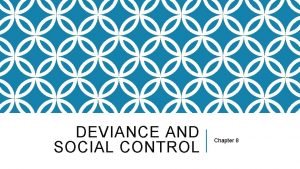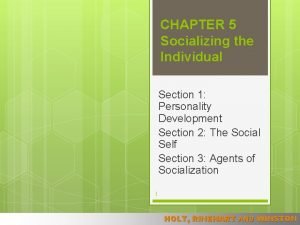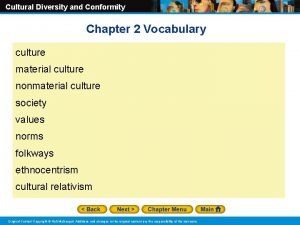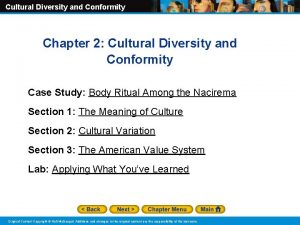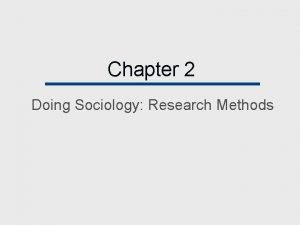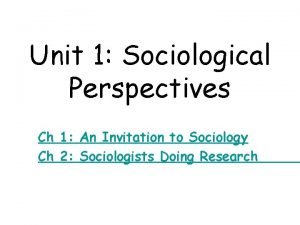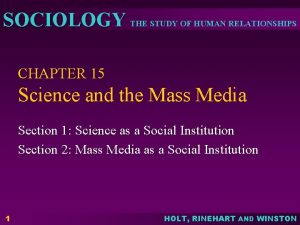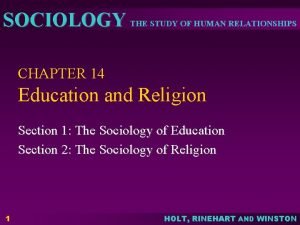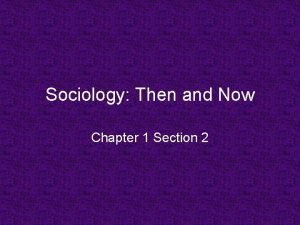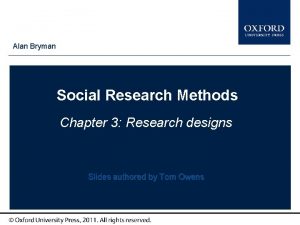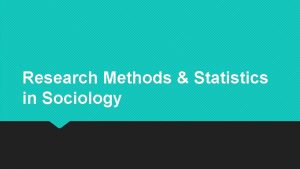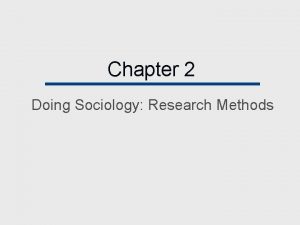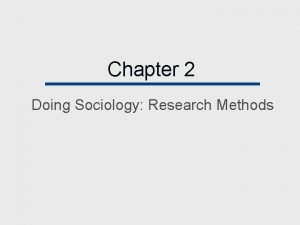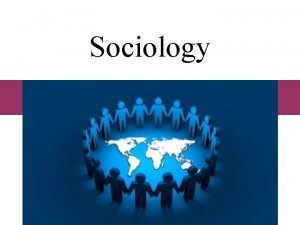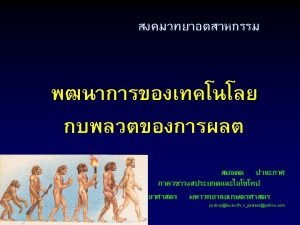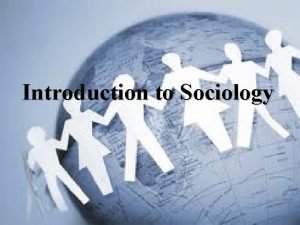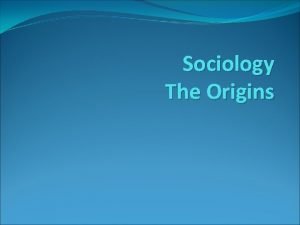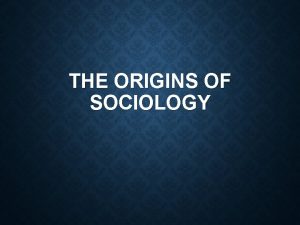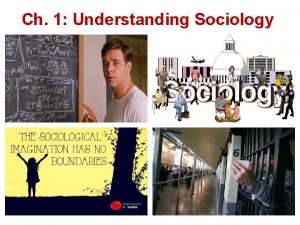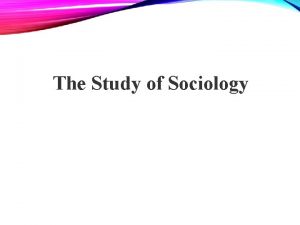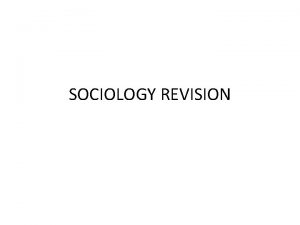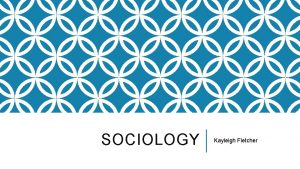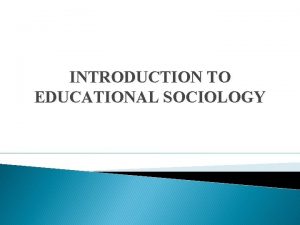Chapter 2 Doing Sociology Research Methods What to



















- Slides: 19

Chapter 2: Doing Sociology: Research Methods

What to Expect in This Chapter. . . n n What are Research Methods? Activities Comprising the Research Process • • n Define the Problem Review Previous Research Develop Hypotheses Determine the Research Design Define the Sample and Collect Data Analyze the Data Prepare the Report How to Read A table

What are Research Methods? Research methods is the term used to refer to a series of activities that allow the researcher to draw conclusions about the world with reasonable certainty and accuracy. n The activities involved are also referred to collectively as the research process. n

Activities Comprising the Research Process

1. Defining the Problem n The first step in defining the problem is identifying the general question you want to answer • For example, you might want to know if drugs are responsible for the decline of morality in this country n The second step involves stating your question so that it can be measured empirically • You might then phrase your question, “Does drug use cause one to commit crime? ” n The third step typically involves operationalizing the concepts you are using • This will involve specifying what you mean by “drug use” and “crime”

2. Review Previous Research It will be rare that you will identify a research problem that has not previously been researched n By looking at what other researchers have done, you can get some ideas about how to conduct your own research n Generally, you can find this research in scholarly journals and books and monographs in college and university libraries n

3. Develop Hypotheses An hypothesis is “. . . a testable statement about the relationship between two or more empirical variables. ” n A variable is “. . . anything that can change” n – An independent variable causes change to occur in another variable – A dependent variable is influenced by the independent variable

3 a. Statements of Causality and Association n Statement of causality—declares that something causes something else Drug Use n Crime Statement of association—declares that two variables are related but one does not necessarily cause the other Drug Use Crime Unknown Third Variable

4. Determine the Research Design. . .

4 a The Survey n n The survey involves questioning a population or sample to reveal certain facts about themselves The survey is usually conducted with the use of a questionnaire or interview – The structured interview uses preset questions and produces very uniform and replicable responses – The open-ended interview allows more freedom for both respondent and interviewer in exploring a topic thoroughly

4 b Participant Observation n n Participant observation involves going into the “field” and spending considerable time interacting with the people one is studying It is generally used to study small groups or communities over an extended period of time The researcher must establish trust and honesty in his or her relationships with the people being studied Results cannot be replicated easily, but it can provide much more detailed information

4 c. The Experiment n The experiment is a design that carefully controls the variables being studied The experiment is the most precise research design available to sociologists (or any other scientist) n The types of things that most sociologists are interested in do not lend themselves to this research design, however n

4 d. Secondary Analysis Secondary analysis involves making use of data that have been previously collected by others n There are several sources of secondary data, including the U. S. Census Bureau, the FBI, Department of Labor and others n

Advantages and Disadvantages of Research Methods Research Method Survey Participant Observation Experiment Secondary Analysis Advantages Disadvantages 1 Many people can be 1 Respondents may give surveyed false information 2 Data can be quantified and 2 Do not leave room for comparisons made unanticipated answers 1 Allows people to be observed in natural habitat 2 Provides greater depth of understanding 1 Findings open to interpretation and subject to bias 2 Results difficult to replicate 1 Variables can be controlled 1 Artificial setting 2 Limited to a few variables 2 Easy to replicate 3 Not appropriate for most sociologists 1 Good for historical and No control over data longitudinal data 2 Saves time and money

5. Define Sample /Collect Data A sample is a subset of a population that is chosen for study n The process by which this subset of the population is chosen is called sampling n The nature of the population and the research will determine what type of sample the researcher will use n

Types of Samples Type of Sample Description Purpose Random Each individual in a population has an equal chance of being chosen Used when there is no need to insure inclusion of certain categories Stratified Random Population first divided into groups based on certain characteristics; random sample drawn within each category Used when representation of certain population categories is important

Avoiding Researcher Bias n n Researcher bias occurs when the researcher tends to ignore data which go against his or her hypotheses This can be prevented using one or more of the following strategies – Allowing other researchers access to one’s data for alternative interpretation – Use of blind investigators who do not know if a subject is part of an experimental or control group – Use of double blind investigators who know neither the nature of the subjects, or of the hypotheses being tested

6. Analyzing the Data n n n Analysis of data is the process by which large and complicated collections of data are organized so that comparisons can be made and conclusions drawn Sociologists use a variety of statistics to assist in this process Two issues are especially important in data analysis: • Validity—the data accurately represent the reality being tested • Reliability—the findings can be repeated

7. Prepare the Research Report n Sociological research is generally reported in one or more of the following ways: – Papers presented at professional meetings – Published in technical or scholarly journals – Published as books or monographs – Published as final reports to funding agencies
 Anything worth doing is not necessarily worth doing well
Anything worth doing is not necessarily worth doing well Doing nothing is doing ill
Doing nothing is doing ill Research methods for business students chapter 5
Research methods for business students chapter 5 Direct and indirect wax pattern
Direct and indirect wax pattern Biographical research design
Biographical research design What is field research in sociology
What is field research in sociology Labeling theory of deviance examples
Labeling theory of deviance examples Sociology chapter 5 socializing the individual
Sociology chapter 5 socializing the individual Sociology chapter 5 socialization
Sociology chapter 5 socialization Sociology chapter 8 deviance and social control
Sociology chapter 8 deviance and social control Sociology chapter 5 socializing the individual
Sociology chapter 5 socializing the individual Sociology chapter 2 cultural diversity and conformity
Sociology chapter 2 cultural diversity and conformity Sociology chapter 1 review
Sociology chapter 1 review Cultural diversity and conformity
Cultural diversity and conformity Advantages and disadvantages of observation method
Advantages and disadvantages of observation method Chapter 1 an invitation to sociology answers
Chapter 1 an invitation to sociology answers Sociology chapter 15
Sociology chapter 15 Sociology chapter 14
Sociology chapter 14 Sociology: then and now
Sociology: then and now Alan bryman social research methods
Alan bryman social research methods


